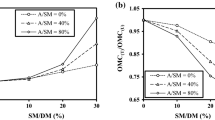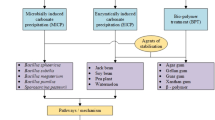Abstract
The strength and hydraulic conductivity of vertical cutoff walls consisting of reactive magnesia-activated ground granulated blast furnace slag (GGBS), bentonite, and soil (MSB) have been investigated in previous studies. However, there has been little comprehensive study of the influence of wet-dry cycles on the mechanical and microstructural properties of MSB backfills. In this paper, the durability of MSB backfills when exposed to wet-dry cycles is investigated. The variations in mass change, dry density, pH value, pore size distribution, and mineralogy are discussed. The results show that the mass change of ordinary Portland cement (OPC)-based and MSB backfills increases with respect to wet-dry cycles. The MSB backfills exhibit up to 8.2% higher mass change than OPC-based ones after 10 wet-dry cycles. The dry density, pH value, and unconfined compressive strength of MSB backfill decrease with the increasing number of wet-dry cycles. Increasing the GGBS-MgO content from 5% to 10% in MSB backfills results in 2.1–2.3 times higher strength, corresponding to a reduction of 2%–12% in cumulative pore volume; while increasing the bentonite content slightly reduces the strength of MSB mixtures, corresponding to an increase of cumulative pore volume by 4.6%–7.9%. The hydrotalcite-like phases and calcium silicate hydrate (C-S-H) are the primary hydration products in MSB backfills. Moreover, the continuous wet-dry cycles result in the precipitation of calcite and nesquehonite.
概要
目 的
-
1.
研究干湿循环作用下氧化镁激发矿渣-膨润土 (MSB) 竖向隔离墙的耐久特性.
-
2.
探讨干湿循环过程中循环级数对隔离墙的质量变化、干密度、pH 值、无侧限抗压强度、孔隙结构和微观产物等的影响, 并探究 MSB 的服役性能.
创新点
-
1.
通过干湿循环作用, 揭示新型 MSB 隔离墙与传统水泥基 (OPC) 隔离墙的耐久性差异;
-
2.
通过微观分析, 成功测定新型 MSB 隔离墙干湿循环后形成的水化产物.
方 法
-
1.
通过宏观实验分析, 在干湿循环作用下比较 MSB 隔离墙和 OPC 隔离墙的质量、干密度、 pH 值和无侧限抗压强度等参数的变化情况 (图 2 和 4~6);
-
2.
通过微观分析, 研究 MSB 隔离墙中氧化镁激发高炉矿渣 (GGBS-MgO) 和膨润土的掺量对空隙结构的影响 (图 8), 并探讨干湿循环作用如何影响碳酸钙和碳酸镁等水化产物的形成 (图9).
结 论
-
1.
MSB 隔离墙的质量损失比 OPC 隔离墙高 1.1%~2.1%;
-
2.
MSB 和 OPC 隔离墙的干密度和 pH 值均随干湿循环级数的增长而减小;
-
3.
MSB 和 OPC 隔离墙的无侧限抗压强度随干湿循环级数的增长而降低;
-
4.
增加 GGBS-MgO 的掺量可减少 2%~12% 的累计进汞量, 而增加膨润土的掺量会增加 4.6%~7.9 %的进汞量;
-
5.
干湿循环可加速碳酸钙和碳酸镁等水化产物的形成.
Similar content being viewed by others
References
Arulrajah A, Kua TA, Suksiripattanapong C, et al., 2017a. Compressive strength and microstructural properties of spent coffee grounds-bagasse ash based geopolymers with slag supplements. Journal of Cleaner Production, 162:1491–1501. https://doi.org/10.1016/j.jclepro.2017.06.171
Arulrajah A, Kua TA, Horpibulsuk S, et al., 2017b. Recycled glass as a supplementary filler material in spent coffee grounds geopolymers. Construction and Building Materials, 151:18–27. https://doi.org/10.1016/j.conbuildmat.2017.06.050
ASTM, 2008. Standard Test Method for Unconfined Compressive Strength Index of Chemical-grouted Soils, ASTM D4219-08. National Standards of USA. https://doi.org/10.1520/D4219-08
ASTM, 2010a. Standard Test Methods for Laboratory Determination of Water (Moisture) Content of Soil and Rock by Mass, ASTM D2216-2010. National Standards of USA.
ASTM, 2010b. Standard Test Methods for Liquid Limit, Plastic Limit, and Plasticity Index of Soils, ASTM D4318. National Standards of USA.
ASTM, 2010c. Standard Test Method for Determination of Pore Volume and Pore Volume Distribution of Soil and Rock by Mercury Intrusion Porosimetry, ASTM D4404-10. National Standards of USA. https://doi.org/10.1520/D4404-10
ASTM, 2010d. Standard Test Method for Measuring the Exchange Complex and Cation Exchange Capacity of Inorganic Fine-grained Soils, ASTM D7503. National Standards of USA.
ASTM, 2014. Standard Test Methods for Specific Gravity of Soil Solids by Water Pycnometer, ASTM D854-14. National Standards of USA. https://doi.org/10.1520/D0854-14
ASTM, 2017. Standard Practice for Classification of Soils for Engineering Purposes (Unified Soil Classification System), ASTM D2487-17. National Standards of USA. https://doi.org/10.1520/D2487-17
ASTM, 2018a. Standard Test Methods for pH of Soils, ASTM D4972-18. National Standards of USA. https://doi.org/10.1520/D4972-18
ASTM, 2018b. Standard Test Methods for Laboratory Determination of Density (Unit Weight) of Soil Specimens, ASTM D7263-09(2018)e2. National Standards of USA. https://doi.org/10.1520/D7263-09R18E02
Benhelal E, Zahedi G, Shamsaei E, et al., 2013. Global strategies and potentials to curb CO2 emissions in cement industry. Journal of Cleaner Production, 51:142–161. https://doi.org/10.1016/j.jclepro.2012.10.049
Cerato AB, Lutenegger AJ, 2002. Determination of surface area of fine-grained soils by the ethylene glycol monoethyl ether (EGME) method. Geotechnical Testing Journal, 25(3):315–321. https://doi.org/10.1520/GTJ11087J
Collins F, Sanjayan JG, 2000. Effect of pore size distribution on drying shrinking of alkali-activated slag concrete. Cement and Concrete Research, 30(9):1401–1406. https://doi.org/10.1016/s0008-8846(00)00327-6
Du YJ, Jiang NJ, Liu SY, et al., 2014. Engineering properties and microstructural characteristics of cement-stabilized zinc-contaminated kaolin. Canadian Geotechnical Journal, 51(3):289–302. https://doi.org/10.1139/cgj-2013-0177
Du YJ, Fan RD, Liu SY, et al., 2015. Workability, compressibility and hydraulic conductivity of zeolite-amended clayey soil/calcium-bentonite backfills for slurry-trench cutoff walls. Engineering Geology, 195:258–268. https://doi.org/10.1016/j.enggeo.2015.06.020
Du YJ, Bo YL, Jin F, et al., 2016. Durability of reactive magnesia-activated slag-stabilized low plasticity clay subjected to drying-wetting cycle. European Journal of Environmental and Civil Engineering, 20(2):215–230. https://doi.org/10.1080/19648189.2015.1030088
Du YJ, Wu J, Bo YL, et al., 2019. Effects of acid rain on physical, mechanical and chemical properties of GGBS-MgO-solidified/stabilized Pb-contaminated clayey soil. Acta Geotechnica, in press. https://doi.org/10.1007/s11440-019-00793-y
Evans JC, 1991. Geotechnics of hazardous waste control systems. In: Fang HY (Ed.), Foundation Engineering Handbook, 2nd Edition. Springer, Boston, USA, p.750–777. https://doi.org/10.1007/978-1-4757-5271-7_20
Horpibulsuk S, Rachan R, Chinkulkijniwat A, et al., 2010. Analysis of strength development in cement-stabilized silty clay from microstructural considerations. Construction and Building Materials, 24(10):2011–2021. https://doi.org/10.1016/j.conbuildmat.2010.03.011
ICE (Institution of Civil Engineers), 1999. Specification for the Construction of Slurry Trench Cut-off Walls: As Barriers to Pollution Migration. Thomas Telford, London, UK. https://doi.org/10.1680/sftcostcw.26254
Jefferis S, 2012. Cement-bentonite slurry systems. In: Johnsen LF, Bruce DA, Byle MJ (Eds.), Grouting and Deep Mixing. ASCE, Reston, USA, p.1–24. https://doi.org/10.1061/9780784412350.0001
Jin F, Al-Tabbaa A, 2014a. Characterisation of different commercial reactive magnesia. Advances in Cement Research, 26(2):101–113. https://doi.org/10.1680/adcr.13.00004
Jin F, Al-Tabbaa A, 2014b. Evaluation of novel reactive MgO activated slag binder for the immobilisation of lead and zinc. Chemosphere, 117:285–294. https://doi.org/10.1016/j.chemosphere.2014.07.027
Jin F, Gu K, Al-Tabbaa A, 2014. Strength and drying shrinkage of reactive MgO modified alkali-activated slag paste. Construction and Building Materials, 51:395–404. https://doi.org/10.1016/j.conbuildmat.2013.10.081
Jin F, Gu K, Al-Tabbaa A, 2015. Strength and hydration properties of reactive MgO-activated ground granulated blastfurnace slag paste. Cement and Concrete Composites, 57:8–16. https://doi.org/10.1016/j.cemconcomp.2014.10.007
Joshi K, Soga K, Ng MYA, et al., 2008. Durability study of eleven years old cement-bentonite cut-off wall material. In: Khire MV, Alshawabkeh AN, Reddy KR (Eds.), GeoCongress 2008: Geotechnics of Waste Management and Remediation. ASCE, New Orleans, USA, p.620–627. https://doi.org/10.1061/40970(309)78
Joshi K, Kechavarzi C, Sutherland K, et al., 2010. Laboratory and in situ tests for long-term hydraulic conductivity of a cement-bentonite cutoff wall. Journal of Geotechnical and Geoenvironmental Engineering, 136(4):562–572. https://doi.org/10.1061/(asce)gt.1943-5606.0000248
Kamon M, Nontananandh S, Katsumi T, 1993. Utilization of stainless-steel slag by cement hardening. Soils and Foundations, 33(3):118–129. https://doi.org/10.3208/sandf1972.33.3_118
Lam C, Jefferis SA, 2017. Polymer Support Fluids in Civil Engineering. ICE Publishing, London, UK. https://doi.org/10.1680/psfce.57869
Li YC, Tong X, Chen Y, et al., 2018. Non-monotonic piezocone dissipation curves of backfills in a soil-bentonite slurry trench cutoff wall. Journal of Zhejiang University-SCIENCE A (Applied Physics & Engineering), 19(4):277–288. https://doi.org/10.1631/jzus.A1700097
Malusis MA, Yeom S, Evans JC, 2011. Hydraulic conductivity of model soil-bentonite backfills subjected to wet-dry cycling. Canadian Geotechnical Journal, 48(8):1198–1211. https://doi.org/10.1139/t11-028
Nahlawi H, Kodikara JK, 2006. Laboratory experiments on desiccation cracking of thin soil layers. Geotechnical and Geological Engineering, 24(6):1641–1664. https://doi.org/10.1007/s10706-005-4894-4
National Research Council, 2007. Assessment of the Performance of Engineered Waste Containment Barriers. The National Academies Press, Washington, USA. https://doi.org/10.17226/11930
Opdyke SM, Evans JC, 2005. Slag-cement-bentonite slurry walls. Journal of Geotechnical and Geoenvironmental Engineering, 131(6):673–681. https://doi.org/10.1061/(asce)1090-0241(2005)131:6(673)
Ross RR, Beljin MS, 1998. Evaluation of containment systems using hydraulic head data. Journal of Environmental Engineering, 124(6):575–578. https://doi.org/10.1061/(asce)0733-9372(1998)124:6(575)
Rowe RK, Bostwick LE, Take WA, 2011. Effect of GCL properties on shrinkage when subjected to wet-dry cycles. Journal of Geotechnical and Geoenvironmental Engineering, 137(11):1019–1027. https://doi.org/10.1061/(asce)gt.1943-5606.0000522
Ruan SQ, Qiu JS, Weng YW, et al., 2019. The use of microbial induced carbonate precipitation in healing cracks within reactive magnesia cement-based blends. Cement and Concrete Research, 115:176–188. https://doi.org/10.1016/j.cemconres.2018.10.018
Ruffing DG, Evans JC, 2014. Case study: construction and in situ hydraulic conductivity evaluation of a deep soil-cement-bentonite cutoff wall. Proceedings of Geo-Congress 2014, p.1836–1848. https://doi.org/10.1061/9780784413272.180
Ryan CR, Day SR, 2002. Soil-cement-bentonite slurry walls. In: O’Neill MW, Townsend FC (Eds.), Deep Foundations 2002: an International Perspective on Theory, Design, Construction, and Performance. Geotechnical Special Publication, New York, USA, p.713–727. https://doi.org/10.1061/40601(256)51
Shand MA, 2006. The Chemistry and Technology of Magnesia. John Wiley & Sons, Hoboken, USA.
Shen SL, Han J, Du YJ, 2008. Deep mixing induced property changes in surrounding sensitive marine clays. Journal of Geotechnical and Geoenvironmental Engineering, 134(6):845–854. https://doi.org/10.1061/(asce)1090-0241(2008)134:6(845)
Shen ZT, Hou DY, Xu WD, et al., 2018. Assessing long-term stability of cadmium and lead in a soil washing residue amended with MgO-based binders using quantitative accelerated ageing. Science of the Total Environment, 643:1571–1578. https://doi.org/10.1016/j.scitotenv.2018.06.321
Shen ZT, Pan SZ, Hou DY, et al., 2019. Temporal effect of MgO reactivity on the stabilization of lead contaminated soil. Environment International, 131:104990. https://doi.org/10.1016/j.envint.2019.104990
Soga K, Joshi K, Evans JC, 2013. Cement bentonite cutoff walls for polluted sites. Proceedings of Coupled Phenomena in Environmental Geotechnics, p.149–165. https://doi.org/10.1201/b15004-15
Tang CS, Shi B, Liu C, et al., 2011. Experimental characterization of shrinkage and desiccation cracking in thin clay layer. Applied Clay Science, 52(1–2):69–77. https://doi.org/10.1016/j.clay.2011.01.032
Wang F, Jin F, Shen ZT, et al., 2016. Three-year performance of in-situ mass stabilised contaminated site soils using MgO-bearing binders. Journal of Hazardous Materials, 318:302–307. https://doi.org/10.1016/j.jhazmat.2016.07.018
Wu HL, Du YJ, Wang F, et al., 2016. Workability and strength characteristics of alkali-activated slag-bentonite backfills for vertical slurry cutoff wall. Journal of Southeast University (Natural Science Edition), 46(S1):25–30 (in Chinese).
Wu HL, Jin F, Bo YL, et al., 2018a. Leaching and microstructural properties of lead contaminated kaolin stabilized by GGBS-MgO in semi-dynamic leaching tests. Construction and Building Materials, 172:626–634. https://doi.org/10.1016/j.conbuildmat.2018.03.164
Wu HL, Zhang D, Ellis BR, et al., 2018b. Development of reactive MgO-based engineered cementitious composite (ECC) through accelerated carbonation curing. Construction and Building Materials, 191:23–31. https://doi.org/10.1016/j.conbuildmat.2018.09.196
Wu HL, Jin F, Ni J, et al., 2019. Engineering properties of vertical cutoff walls consisting of reactive magnesia-activated slag and bentonite: workability, strength, and hydraulic conductivity. Journal of Materials in Civil Engineering, 31(11):04019263. https://doi.org/10.1061/(asce)mt.1943-5533.0002908
Xia WY, Du YJ, Li FS, et al., 2019a. Field evaluation of a new hydroxyapatite based binder for ex-situ solidification/stabilization of a heavy metal contaminated site soil around a Pb-Zn smelter. Construction and Building Materials, 210:278–288. https://doi.org/10.1016/j.conbuildmat.2019.03.195
Xia WY, Du YJ, Li FS, et al., 2019b. In-situ solidification/stabilization of heavy metals contaminated site soil using a dry jet mixing method and new hydroxyapatite based binder. Journal of Hazardous Materials, 369:353–361. https://doi.org/10.1016/j.jhazmat.2019.02.031
Yang YL, Reddy KR, Du YJ, et al., 2018a. Short-term hydraulic conductivity and consolidation properties of soil-bentonite backfills exposed to CCR-impacted ground-water. Journal of Geotechnical and Geoenvironmental Engineering, 144(6):04018025. https://doi.org/10.1061/(asce)gt.1943-5606.0001877
Yang YL, Reddy KR, Du YJ, et al., 2018b. Sodium hexametaphosphate (SHMP)-amended calcium bentonite for slurry trench cutoff walls: workability and microstructure characteristics. Canadian Geotechnical Journal, 55(4):528–537. https://doi.org/10.1139/cgj-2017-0291
Yang YL, Reddy KR, Du YJ, et al., 2019. Retention of Pb and Cr(VI) onto slurry trench vertical cutoff wall backfill containing phosphate dispersant amended Ca-bentonite. Applied Clay Science, 168:355–365. https://doi.org/10.1016/j.clay.2018.11.023
Yi YL, Liska M, Al-Tabbaa A, 2014. Properties of two model soils stabilized with different blends and contents of GGBS, MgO, lime, and PC. Journal of Materials in Civil Engineering, 26(2):267–274. https://doi.org/10.1061/(asce)mt.1943-5533.0000806
Zhang WB, Rao WB, Li L, et al., 2019. Compressibility and hydraulic conductivity of sand-attapulgite cut-off wall backfills. Journal of Zhejiang University-SCIENCE A (Applied Physics & Engineering), 20(3):218–228. https://doi.org/10.1631/jzus.a1800548
Author information
Authors and Affiliations
Contributions
Hao-liang WU conducted all experiments and processed the corresponding data. Hao-liang WU wrote the first draft of the manuscript. Fei JIN and Yan-jun DU helped to organize the manuscript. Yan-jun DU designed the research. Hao-liang WU, Fei JIN, and Yan-jun DU revised and edited the final version.
Corresponding author
Ethics declarations
Hao-liang WU, Fei JIN, and Yan-jun DU declare that they have no conflict of interest.
Additional information
Project supported by the National Key Research and Development Program (Nos. 2018YFC1803100 and 2018YFC1802300), the National Natural Science Foundation of China (No. 41877248), and the Primary Research & Development Plan of Jiangsu Province (No. BE2017715), China
Rights and permissions
About this article
Cite this article
Wu, Hl., Jin, F. & Du, Yj. Influence of wet-dry cycles on vertical cutoff walls made of reactive magnesia-slag-bentonite-soil mixtures. J. Zhejiang Univ. Sci. A 20, 948–960 (2019). https://doi.org/10.1631/jzus.A1900300
Received:
Accepted:
Published:
Issue Date:
DOI: https://doi.org/10.1631/jzus.A1900300
Key words
- Cutoff wall
- Reactive MgO-activated ground granulated blast furnace slag (GGBS)
- Durability
- Wet-dry cycles
- Carbonation




